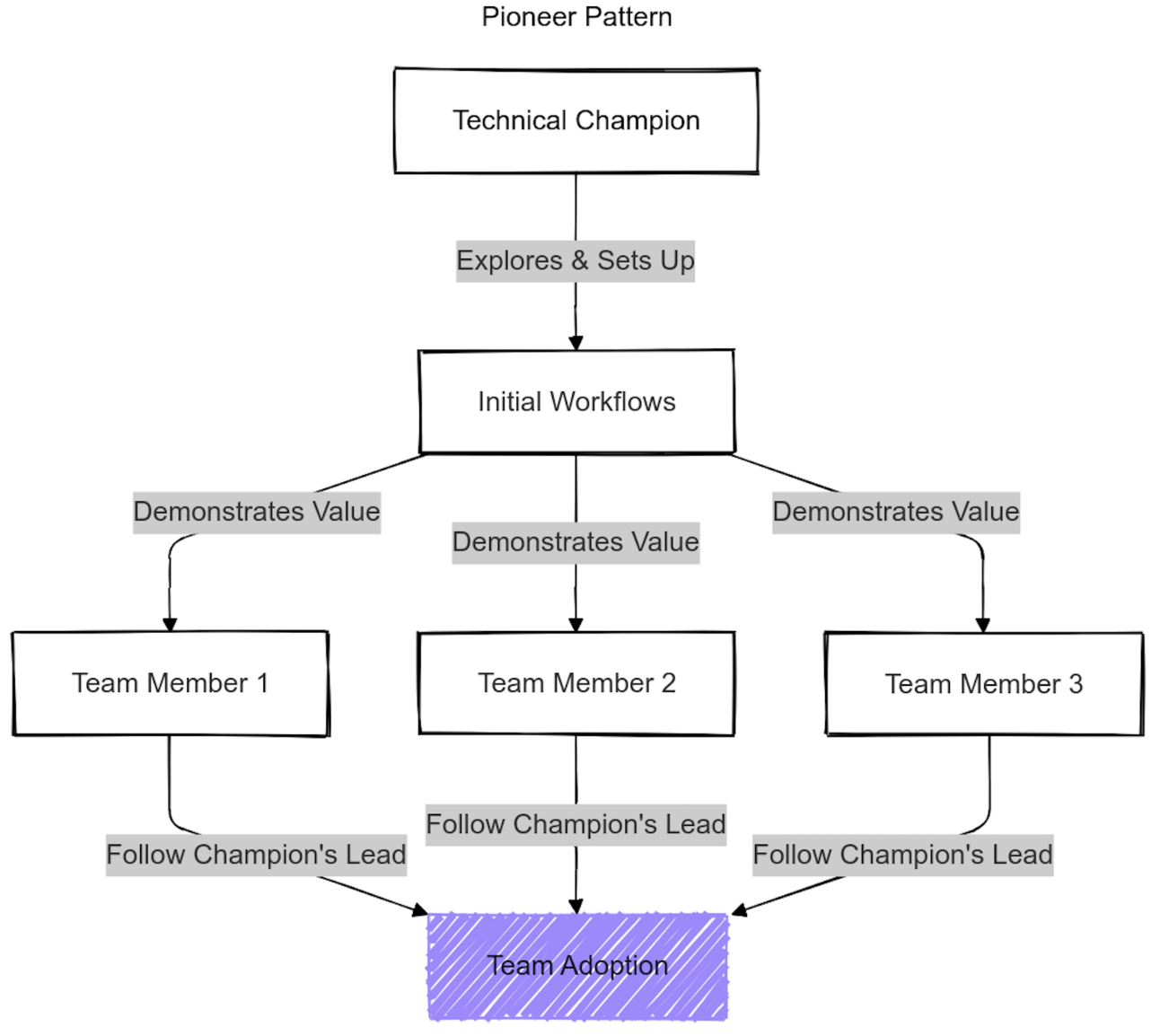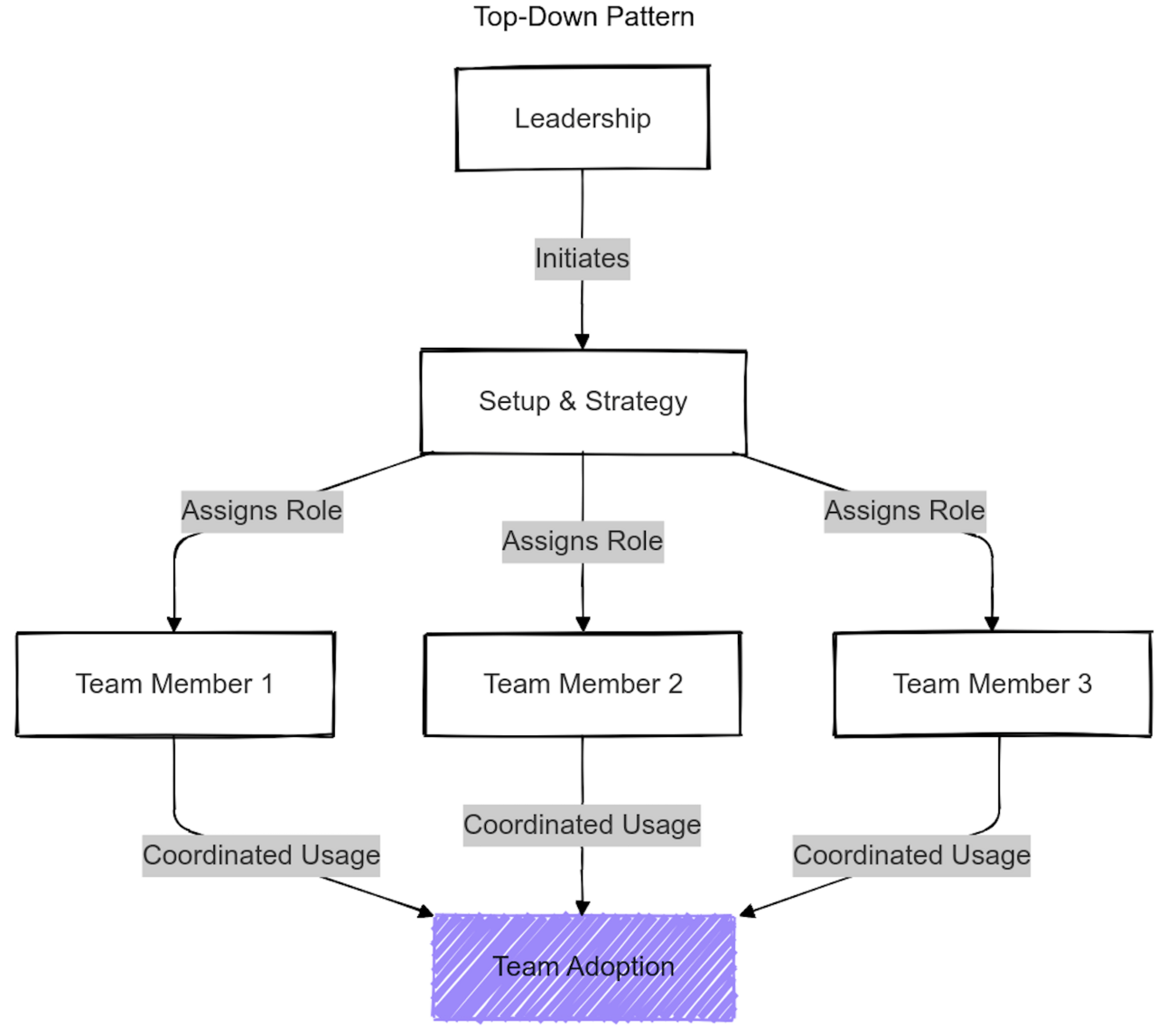Hey {{ first_name | folks }}! 👋
Here’s what you’ll learn in today’s Product-Led Geek:
The mistake you need to avoid in B2B activation
Why traditional PLG activation metrics fail in B2B (and the hidden team dynamics most products ignore)
The three distinct patterns of team activation I've observed across successful B2B products
Total reading time: 7 minutes
Let’s go!

TOGETHER WITH DOVETAIL
From AI analysis to insights where you work, Dovetail 3.0 is more than just an upgrade for research—it’s a whole new way to understand customers.
Get the next generation of customer insights. Dovetail’s automated analysis does the heavy lifting across calls, documents, survey responses, and more.
Please support our sponsors!

GEEK OUT
Stop Making This Activation Mistake
In B2C, activation is straightforward: one user, one journey.
But B2B?
That's a different game - one that most PLG playbooks get wrong by focusing too much on individual user journeys.
Successful product-led growth in B2B means enabling teams to discover, adopt, and expand usage - often without direct sales involvement.
In B2B, you see distributed activation patterns - where different team members play different roles in the activation journey.
Here's what it often looked like in anything but the smallest teams at Snyk:
A security champion would complete the initial setup.
Developers would experience the aha moment of finding vulnerabilities.
Team leads would establish workflows that drove the habit moment.
Activation wasn't a solo act.
It required harmonising distinct user roles.
It was so important for Snyk that we used a big banner at the top of the app to drive multi-player adoption.

Snyk is not unique here.
This is the reality of most B2B software, but it isn’t written about enough, and growth teams don’t put enough emphasis on it.
in B2B, every user action happens in the context of a team, workspace, company, or account.
People (users) work together in a team.
Why Teams Activate Differently
Team activation complexities challenge traditional PLG assumptions.
Individual adoption might be straightforward (sign up, configure, use), but in B2B, team adoption involves layers of human coordination that change the game.
For example, implementing a new security scanning tool is complex and multi-layered.
First, there's the coordination challenge of getting everyone to find time for setup.
But that's just the start. You need:
Developers to understand and buy into the importance of security scanning.
Developers to discover value through hands-on scanning.
Security teams to trust and validate the tool's approach.
Team leads to agree on when and how to run scans.
Everyone to align on what constitutes a "must-fix" vulnerability.
…
Each step requires its own mini-journey of discovery and alignment.
When teams using Snyk skipped these coordination steps, we'd see inconsistent or ignored tool usage - despite perfect technical implementation.
Role specialisation adds another layer of complexity.
We saw how different team members would interact with the product differently.
A security engineer's journey differed from a developer's, yet both were essential for successful activation, particularly in larger teams.
This specialisation means you can't design one perfect path. You need to create an ecosystem that supports multiple parallel journeys.
Then there's the organisational dynamics - the invisible force that shapes everything.
It’s common for a team to stall due to an unaccounted approval process, even when all the technical pieces are in place.
You need to map and navigate these organisational realities, which are part of the terrain.
Teams activate differently from individual users because they need to:
Build shared understanding of the product's value.
Establish workflows that are specific to each team.
Navigate existing processes and constraints.
Align incentives across roles.
Factor | Key Considerations |
|---|---|
Coordination | Scheduling, communication, decision-making, resource allocation |
Role Specialisation | User types, permissions, use cases, workflows |
Organisational Dynamics | Approval processes, security requirements, compliance, budget |
Common Team Activation Patterns
I've noticed recurring patterns for B2B activation through my work and conversations with PLG companies.
[diagram showing the three patterns]
1. The Pioneer Pattern
This is the classic bottom-up PLG motion at team scale.
A technical champion discovers the product.
They start experimenting with self-serve features and begin building value independently.
They create initial workflows and gradually involve other team members.
They nurture the initial growth and help it spread.

The key to PLG success isn't just their initial activation. It's how the product enables them to demonstrate value to their team without sales support.
This was a common pattern at Snyk.
Most successful pioneer-led adoptions started with a security-minded developer who understood both the technical and organisational challenges.
They'd set up initial scans, demonstrate value through detection of security issues, work with other devs on real vulnerability fixes, and gradually bring their team along.
The product helped them spread adoption.
2. The Top-Down Pattern
While this might sound like traditional enterprise sales, modern B2B PLG tools (and their companies) support a unique hybrid approach.
Customer leadership assigns roles, coordinates the rollout, and ensures everyone knows their part.

The product enables:
Self-serve enterprise trials.
Automated onboarding of team members.
Role-based feature discovery.
Usage analytics for leadership.
As customer scale increases, you’ll potentially support the customer with low touch (SMBs, often 1:many) or high-touch (mid-market and enterprise) human involvement.
At Snyk, this pattern would most commonly be seen due to a customer security mandate or compliance requirement.
However, even when adoption started top-down, the most successful implementations used our product-led features to drive organic team engagement rather than relying on mandate alone.
3. The Organic Pattern
This is product-led growth at its most viral.
Multiple team members independently discover the product through various channels like content, community, and integrations.
They start collaborating informally, and then setup happens in parallel.
Finally, usage patterns naturally converge.

The product drives adoption by:
Surfacing collaboration opportunities
Enabling easy workspace sharing
Showing team-wide impact metrics
Facilitating discovery across teams
We frequently saw this in larger organisations where different teams would start using Snyk independently, eventually leading to organisation-wide adoption driven by demonstrated value rather than a central mandate.
Common Failure Modes
Each pattern has its own failure modes.
Understanding these helps us build better experiences (in and out of product) that get more teams to value and habit more often.
Pioneer Pattern Pitfalls
The most common failure mode here is champion burnout.
A passionate technical champion discovers your product through self-serve channels, sets it up perfectly, and demonstrates value.
But without proper product support for team expansion, they eventually get pulled into other priorities.
The product becomes a team-wide solution instead of "that thing Sarah was excited about."
When the champion moves on to a new role or company, it’s worse.
I've seen entire product-led implementations stall because the one person who understood the product's value left, taking all the context and momentum with them.
The lesson?
Your PLG motion can't rely solely on champions.
The product needs built-in mechanisms to spread knowledge and enthusiasm across the team.
Top-Down Pattern Problems
The top-down pattern often fails in the mandate without meaning scenario.
Leadership identifies a significant problem to assign resources, sets up formal processes, assigns roles, and then nobody engages meaningfully.
It looks great on paper - high install numbers, completed setup steps - but usage is shallow and mechanical.
Another classic top-down failure is the partial deployment paralysis.
A team encounters an unexpected security or compliance hurdle 90% through their planned rollout, and the implementation gets stuck in limbo.
These technical hurdles can kill product-led momentum without built-in features for enterprise governance or guidance through common blockers.
Organic Pattern Obstacles
The biggest enemy of the organic pattern is collaboration chaos.
Multiple team members discover your product, but each uses it in isolation.
You can end up with duplicate setups, conflicting workflows, and fragmented usage patterns.
Instead of benefiting from viral team adoption, the product becomes a source of friction.
For some products, independent use is fine and causes no problem when converged.
In others, it’s something you need to be aware of.
I'll use Snyk as an example.
If different development teams set up their own vulnerability scanning configurations without coordinating, there’s a risk of inconsistent severity thresholds, different ignore rules, and no shared understanding of what needed fixing.
The individual pieces might work, but the team won’t get the full value of coordinated security coverage.
The real problem is the lack of governance on the customer process side.
However, be aware of it when serving those kinds of audiences.
Measuring Team Activation
Moving from individual to team-based activation metrics requires a shift in thinking.
User-level activation metrics will paint an incomplete picture.
You’ll see users completing key actions, but you won’t see how those actions contribute to team success.
For a deep dive on the metrics side of this, I encourage you to take a look at my previous post:
Optimising Team Success
The key to successful team activation in PLG is creating product experiences that drive team-wide adoption and expansion.
After helping many B2B companies improve their activation journeys, I've learned that success comes from thinking in systems, not steps.
You need to create an environment that supports team-wide discovery and adoption, because optimising individual user journeys isn't enough.
Start by mapping your team journeys.
Not just the happy path, but all the weird and wonderful ways teams adopt your product.
Expect that exercise to reveal unexpected adoption patterns.
Successful teams may be using the product in ways you hadn't designed for, but that work perfectly for their context.
Design for collaboration from the beginning.
This goes beyond adding sharing features. You have to create spaces for team members to discover and build on each other's work.
Build in visibility that helps teams coordinate naturally, without forcing specific workflows.
Support multiple patterns.
Successful teams don't always follow your preferred adoption pattern.
They find a pattern that works for their context.
Your job is to enable that discovery and adaptation.
Looking Ahead
While most PLG playbooks focus on single-user activation, B2B requires us to rethink how products drive team-wide adoption without heavy sales involvement.
My top 3 takeaways:
Design for Distributed Discovery. Your product needs to support multiple parallel PLG journeys. Different team members will find and adopt your product in different ways. Build features that turn this natural behaviour into a strength.
Enable Organic Expansion. Instead of relying on sales for team adoption, create product experiences that spread value across teams. Every activated user should become a potential vector for viral growth.
Measure Team Success. Move beyond individual PLG metrics to track team-wide activation and organic expansion. Understanding team adoption will help you build better product-led experiences.
In B2B PLG, success means creating product experiences that drive team-wide adoption and expansion, and orchestrating a team journey that creates lasting, collaborative value.
I'd love to hear from you if you're applying these team-based PLG approaches in your product (just reply to this email).
P.S. If you're interested in more thoughts on activation timing, check out my post on the Time-To-Value Paradox, where I explore why slower onboarding can lead to faster growth.
Enjoying this content? Subscribe to get every post direct to your inbox!

GEEK OF THE WEEK
What's the most impactful piece of user feedback you've ever received?
"I forgot I signed up for this product; thanks for reminding me!".
For me, despite all the industry benchmarks in the world, this signals that your engagement campaign is never too much until your users say so!
I want to share YOUR stories.
Favourite metrics, unconventional growth tactics, failures and learnings, surprising insights and more.
If you want to be featured in Geek Of The Week, fill in this short form.

THAT’S A WRAP
Before you go, here are 3 ways I can help:
Take the FREE Learning Velocity Index assessment - Discover how your team's ability to learn and leverage learnings stacks up in the product-led world. Takes 2 minutes and you get free advice.
Book a free 1:1 consultation call with me - I keep a handful of slots open each week for founders and product growth leaders to explore working together and get some free advice along the way. Book a call.
Sponsor this newsletter - Reach over 7800 founders, leaders and operators working in product and growth at some of the world’s best tech companies including Paypal, Adobe, Canva, Miro, Amplitude, Google, Meta, Tailscale, Twilio and Salesforce.
That’s all for today,
If there are any product, growth or leadership topics that you’d like me to write about, just hit reply to this email or leave a comment and let me know!
And if you enjoyed this post, consider upgrading to a VIG Membership to get the full Product-Led Geek experience and access to every post in the archive including all guides.
Until next time!
— Ben
PS: Thanks again to our sponsor: Dovetail

